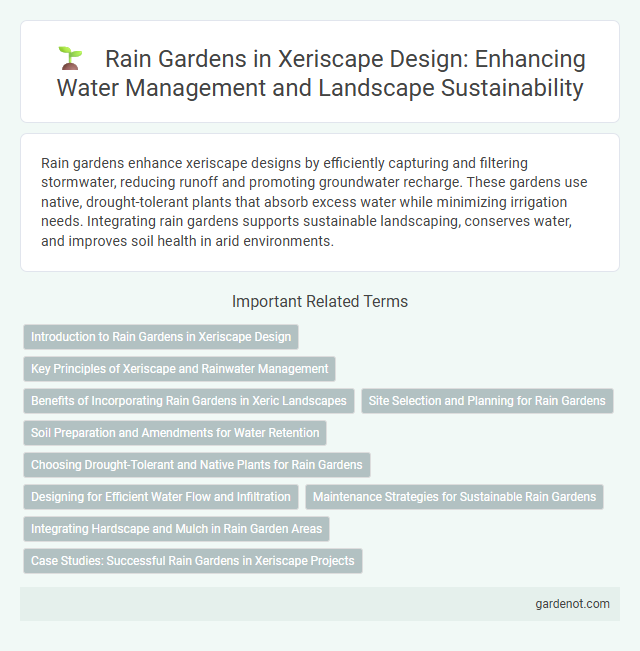Rain gardens enhance xeriscape designs by efficiently capturing and filtering stormwater, reducing runoff and promoting groundwater recharge. These gardens use native, drought-tolerant plants that absorb excess water while minimizing irrigation needs. Integrating rain gardens supports sustainable landscaping, conserves water, and improves soil health in arid environments.
Introduction to Rain Gardens in Xeriscape Design
Rain gardens are a key component of xeriscape design, effectively managing stormwater while enhancing landscape aesthetics. These shallow, planted depressions capture and filter rainwater runoff, promoting groundwater recharge and reducing erosion. Selecting native, drought-tolerant plants maximizes water efficiency and supports local biodiversity within xeriscape landscapes.
Key Principles of Xeriscape and Rainwater Management
Rain gardens exemplify key principles of xeriscape by efficiently managing rainwater through natural infiltration and reducing runoff. Incorporating native, drought-tolerant plants in rain gardens minimizes water use while enhancing soil absorption and filtration. Strategic site selection and soil amendment further optimize water conservation and support sustainable landscaping practices.
Benefits of Incorporating Rain Gardens in Xeric Landscapes
Rain gardens enhance xeriscapes by capturing and filtering stormwater, reducing runoff and improving groundwater recharge. Native, drought-tolerant plants used in rain gardens thrive in dry conditions while providing habitat for pollinators and enhancing biodiversity. Incorporating rain gardens lowers landscape maintenance needs and contributes to sustainable water management in arid environments.
Site Selection and Planning for Rain Gardens
Selecting an ideal site for a rain garden involves identifying low-lying areas that naturally collect runoff from impervious surfaces such as driveways and rooftops. Soil permeability and drainage patterns must be assessed to ensure proper infiltration and prevent waterlogging, favoring sandy or loamy soils. Planning includes sizing the garden to accommodate the catchment area's runoff volume, typically covering 20-30% of the impervious surface to optimize stormwater management and maximize groundwater recharge.
Soil Preparation and Amendments for Water Retention
Rain garden soil preparation involves amending native soil with organic matter such as compost and sand to enhance water retention and drainage balance. Incorporating materials like biochar or clay can improve moisture-holding capacity, crucial for managing stormwater effectively. Properly conditioned soil supports plant health and maximizes the xeriscape's efficiency in reducing irrigation needs.
Choosing Drought-Tolerant and Native Plants for Rain Gardens
Selecting drought-tolerant and native plants for rain gardens enhances water efficiency and supports local ecosystems by reducing irrigation needs and promoting soil health. Native species such as purple coneflower (Echinacea purpurea), blue flag iris (Iris versicolor), and switchgrass (Panicum virgatum) thrive in varying moisture conditions and improve stormwater absorption. Incorporating plants adapted to local climate conditions ensures sustainable landscaping that minimizes water waste and maximizes environmental benefits.
Designing for Efficient Water Flow and Infiltration
Rain gardens in xeriscape design maximize water retention and infiltration by strategically grading the landscape to direct runoff toward depressed planting areas filled with permeable soil and native vegetation. Incorporating mulch layers and selecting plants with deep root systems further enhance soil structure, promoting efficient water absorption and reducing surface erosion. Proper sizing and placement ensure that rain gardens capture peak stormwater flows, preventing runoff and replenishing groundwater supplies effectively.
Maintenance Strategies for Sustainable Rain Gardens
Effective maintenance strategies for sustainable rain gardens include regular removal of invasive weeds, proper mulching to retain soil moisture, and monitoring soil moisture levels to prevent erosion and nutrient runoff. Selecting native, drought-tolerant plants reduces irrigation needs and supports local biodiversity, while periodic inspection of rain garden inlets and outlets ensures efficient stormwater management. Consistent debris clearance and seasonal pruning preserve plant health and maintain the garden's water filtration capacity.
Integrating Hardscape and Mulch in Rain Garden Areas
Integrating hardscape elements such as permeable pavers and natural stone pathways within rain garden areas enhances water infiltration while preventing soil erosion. Using organic mulch like shredded bark or composted leaves around plants aids in moisture retention and weed suppression, promoting healthier vegetation growth. This combination of hardscape and mulch optimizes rain garden performance by balancing aesthetics with functional stormwater management.
Case Studies: Successful Rain Gardens in Xeriscape Projects
Case studies of successful rain gardens in xeriscape projects highlight significant water conservation improvements in arid regions such as Phoenix, Arizona, where native plants like Penstemon and Muhly grass reduce runoff and support groundwater recharge. Research from the University of New Mexico demonstrates that integrating rain gardens in xeriscape landscapes decreases irrigation needs by up to 30% while enhancing urban biodiversity. These projects validate the effectiveness of rain gardens combined with drought-tolerant species to create sustainable, low-maintenance landscapes that mitigate flash flooding and promote ecological health.
Rain garden Infographic

 gardenot.com
gardenot.com